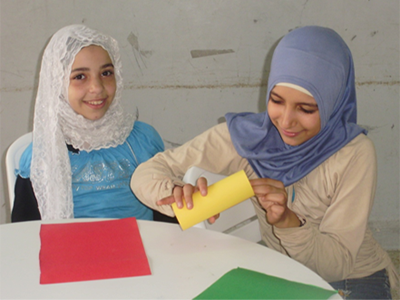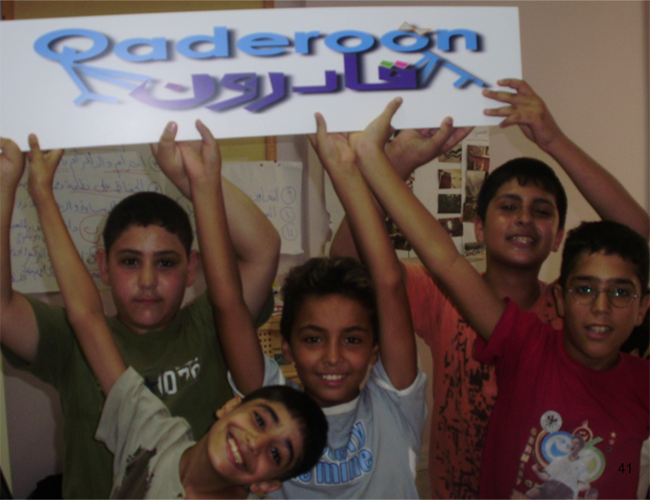
Background
The ‘Qaderoon’ (Arabic for ‘we are capable’) intervention addressed improving the mental health of Palestinian youth in the Burj el Barajneh (BBC) Palestinian refugee camp in Beirut, Lebanon.
Cultural adaptation of the intervention for the context of the community was critical.
Build a Culturally Competent Organization
Mental health was prioritized as the most pressing issue for youth to be addressed by the intervention. However, the term “mental health” created some resistance from the BBC community, as the term for mental health in Arabic can be confused with mental illness. The end decision was to keep the term, as it allowed for a chance to raise awareness within the community.
When the intervention was still being developed, the process of cultural adaptation was led by a graduate student studying psychology, who was a member of the Community Youth Coalition (CYC, a local coalition established for the Qaderoon project) with background experience in youth education in the camp. Another young person with a degree in social work and sociology also aided the process. Some key principles were subsequently agreed upon:
- To focus on terms and expressions used by youth in their context
- To have interactive activities rather than lectures to decrease the need for writing since writing skills were not properly developed
- To focus less on introspection due to its not being common in the culture and more on collective activities focused on social and cognitive skills
- To consider gender issues, as the community was conservative and girls and boys are segregated in school
- To consider the use of art and other forms of expression
- To extend the timing of activities to allow for enough exposure to concepts that are not as common in their context
With these principles in mind, activities were adapted. Each session began by identifying the session objective, followed by a detailed description of activities to meet the objectives and time allocated to each.
When the intervention was being implemented, facilitators and mentors noted that the children would, at times, have short attention spans. Energizers and songs were developed and used as needed. Several issues related to the unique culture and context arose and had to be dealt with such as seating arrangements of girls and boys and specific topics for role plays. The presence of youth mentors greatly facilitated these decisions. A reward system (stars) was created to make sure ground rules were followed by the children. Weekly discussions between facilitators were held, and changes in activities were made accordingly.
Parents were often a barrier to the youth’s participation in the intervention. Interviews with parents quickly concluded that it was either because they were not aware of when t sessions were being held, or that they did not see educational value to ‘Qaderoon’ and preferred to have their children study at home. This barrier was addressed by the creation of English reading sessions to increase perceived educational value of the program by parents. Additionally, monthly schedules were sent home with children so that parents would know when the sessions were taking place. The presence and respect of CYC members in the community also led to the cooperation of parents, as they (the parents) felt like they could vocalize their feelings about the program to the CYC members, who in turn, would discuss any noteworthy concerns the parents would have at future meetings. These discussions indicated great community support for the ‘Qaderoon’ intervention and perceived impact on social skills of participating children.
Build a Culturally Inclusive Community
Including as many community members as possible in discussion and participation was particularly important during the project development phase, where issues arose.
Barriers to participation in the intervention included cultural norms that exist in patriarchal societies in which youth cannot speak freely and vocally in front of adults, particularly if they disagree. This is especially true in close-knit small communities where all inhabitants know one another. In order to move past this barrier, the youth created their own committee where they could talk freely, going so far as to empower two representatives to attend the CYC (Community Youth Coalition) meetings to take part in development phase discussions.
Patriarchal communities also impose specific roles for males and females. In this context, that meant that men were the bread winners, which in turn meant they were often working more than one job to make ends meet. Therefore, there was some difficulty engaging them, as their time off was limited and justifiably spent seeing their families. One of the ideas the CYC came up with in order to get information from fathers was to have the working fathers speak to other fathers who were already involved in the project input.
Prior to the intervention phase, the issue of mixed gender groups (mentioned above) was discussed at length with the CYC. It was concluded that, despite the conservative nature of the community, mixed gender groups were acceptable when the intent was educational and to serve the community.
With sensitivity to the local culture and context, this intervention was able to be successfully adapted and implemented, with 94% of participants stating satisfaction with the intervention.
Reference
Nakkash RT, Alaouie H, Haddad P, El Hajj T, Salem H, Mahfoud Z, Afifi RA. Process evaluation of a community-based mental health promotion intervention for refugee children. Health Educ Res. 2012;27(4):595–607. doi: 10.1093/her/cyr062
Contributed by Leah Soweid, American University of Beirut, Intern with the Community Tool Box.




